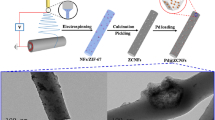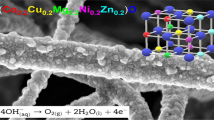Abstract
In this work, the mesoporous SiO2 nanofibers from pyrolyzing precursor of electrospun nanofibers were employed as support to immobilize PtNi nanocatalyst (PtNi/SiO2 nanofibers). AFM, XRD, SEM, TEM, XPS, ICP-AES and N2 adsorption/desorption analysis were applied to systematically investigate the morphology and microstructure of as-prepared products. Results showed that PtNi alloy nanoparticles with average diameter of 18.7 nm were formed and could be homogeneously supported on the surface of porous SiO2 nanofiber, which further indicated that the SiO2 nanofibers with well-developed porous structure, large specific surface area, and roughened surface was a benefit for the support of PtNi alloy nanoparticles. The PtNi/SiO2 nanofibers catalyst exhibited an excellent catalytic activity towards the reduction of p-nitrophenol, and the catalyst’s kinetic parameter (k n = 434 × 10−3 mmol s−1 g−1) was much higher than those of Ni/SiO2 nanofibers (18 × 10−3 mmol s−1 g−1), Pt/SiO2 nanofibers (55 × 10−3 mmol s−1 g−1) and previous reported PtNi catalysts. The catalyst could be easily recycled from heterogeneous reaction system based on its good magnetic properties (the Ms value of 11.48 emu g−1). In addition, PtNi/SiO2 nanofibers also showed an excellent stability and the conversion rate of p-nitrophenol still could maintain 94.2% after the eighth using cycle.









Similar content being viewed by others
References
Ahmadi M, Cui C, Mistry H, Strasser P, Cuenya BR (2015) Carbon monoxide-induced stability and atomic segregation phenomena in shape-selected octahedral PtNi nanoparticles. ACS Nano 9:10686–10694. doi:10.1021/acsnano.5b01807
Bae S, Gim S, Kim H, Hanna K (2016) Effect of NaBH4 on properties of nanoscale zero-valent iron and its catalytic activity for reduction of p-nitrophenol. Appl Catal B-Environ 182:541–549. doi:10.1016/j.apcatb.2015.10.006
Bae SE, Gokcen D, Liu P, Mohammadi P, Brankovic SR (2012) Size effects in monolayer catalysis-model study: Pt submonolayers on Au(111). Electrocatalysis-US 3:203–210. doi:10.1007/s12678-012-0082-5
Bai S, Shen XP, Zhu GX, Xu Z, Yang J (2012) In situ growth of FeNi alloy nanoflowers on reduced graphene oxide nanosheets and their magnetic properties. CrystEngComm 14:1432–1438. doi:10.1039/C1CE05916E
Chen X, Murugananthan M, Zhang Y (2016) Degradation of p-Nitrophenol by thermally activated persulfate in soil system. Chem Eng J 283:1357–1365. doi:10.1016/j.cej.2015.08.107
Deka P, Bhattacharjee D, Sarmah P, Deka RC, Bharali P (2017) Catalytic reduction of water contaminant ‘4-Nitrophenol’ over manganese oxide supported Ni nanoparticles. In: Kurisu F, Ramanathan AL, Kazmi AA, Kumar M (eds) Trends in Asian water environmental science and technology. Springer International Publishing, New Delhi, pp 35–48
Fu K, Wang Y, Mao LC, Jin JH, Yang SL et al (2016) Facile one-pot synthesis of graphene-porous carbon nanofibers hybrid support for Pt nanoparticles with high activity towards oxygen reduction. Electrochimi Acta 215:427–434. doi:10.1016/j.electacta.2016.08.111
Guo QH, Liu D, Zhang XP, Li LB, Hou HQ et al (2014) Pd-Ni alloy nanoparticle/carbon nanofiber composites: preparation, structure, and superior electrocatalytic properties for sugar analysis. Anal Chem 86:5898–5905. doi:10.1021/ac500811j
Ghosh SK, Mandal M, Kundu S, Nath S, Pal T (2004) Bimetallic Pt-Ni nanoparticles can catalyze reduction of aromatic nitro compounds by sodium borohydride in aqueous solution. Appl Catal A-Gen 268:61–66. doi:10.1016/j.apcata.2004.03.017
Hu Y, Chua DHC (2016) Synthesizing 2D MoS2 nanofins on carbon nanospheres as catalyst support for proton exchange membrane fuel cells. Sci Rep-UK 6:28088. doi:10.1038/srep28088
He HC, Li YN (1988) The phase transformations and structure of Cu83.34Pt16.86 alloy. J Mater Sci 23:1558–1562. doi:10.1007/BF01115691
Kim HJ, Choi SM, Nam SH, Seo MH, Kim WB (2009) Carbon-supported PtNi catalysts for electrooxidation of cyclohexane to benzene over polymer electrolyte fuel cells. Catal Today 146:9–14. doi:10.1016/j.cattod.2008.11.012
Kageyama S, Seino S, Nakagawa T, Nitani H, Ueno K et al (2011) Formation of PtRu alloy nanoparticle catalyst by radiolytic process assisted by addition of dl-tartaric acid and its enhanced methanol oxidation activity. J Nanopart Res 13:5275. doi:10.1007/s11051-011-0513-x
Kang YS, Yoo SJ, Lee MJ, Kim MJ, Lee SY et al (2016) Facile synthesis of platinum alloy electrocatalyst via aluminum reducing agent and the effect of post heat treatment for oxygen reduction reaction. Int J Hydrogen Energ 41:22953–22962. doi:10.1016/j.ijhydene.2016.09.147
Lee JB, Jeong SI, Bae MS, Yang DH, Heo DN et al (2011) Highly porous electrospun nanofibers enhanced by ultrasonication for improved cellular infiltration. Tissue Eng Part A 17:2695–2702. doi:10.1089/ten.TEA.2010.0709
Leofanti G, Padovan M, Tozzola G, Venturelli B (1998) Surface area and pore texture of catalysts. Catal Today 41:207–219. doi:10.1016/S0920-5861(98)00050-9
Li XH, Wang X, Antonietti M (2012) Mesoporous g-C3N4 nanorods as multifunctional supports of ultrafine metal nanoparticles: hydrogen generation from water and reduction of nitrophenol with tandem catalysis in one step. Chem Sci 3:2170–2174. doi:10.1039/C2SC20289A
Liu J, Wu Q, Huang F, Zhang H, Xu S et al (2013) Facile preparation of a variety of bimetallic dendrites with high catalytic activity by two simultaneous replacement reactions. RSC Adv 3:14312–14321. doi:10.1039/C3RA41268G
Ma Y, Wang R, Wang H, Linkov V, Ji S (2014) Evolution of nanoscale amorphous, crystalline and phase-segregated PtNiP nanoparticles and their electrocatalytic effect on methanol oxidation reaction. Phys Chem Chem Phys 16:3593–3602. doi:10.1039/c3cp54600d
Ohkubo Y, Hamaguchi Y, Seino S, Nakagawa T, Kageyama S et al (2013) Preparation of carbon-supported PtCo nanoparticle catalysts for the oxygen reduction reaction in polymer electrolyte fuel cells by an electron-beam irradiation reduction method. J Mater Sci 48:5047–5054. doi:10.1007/s10853-013-7292-y
Ogunlaja AS, Kleyi PE, Walmsley RS, Tshentu ZR (2016) Nanofiber-supported metal-based catalysts. ACS Catal 28:144–174. doi:10.1039/9781782626855-00144
Song P, Feng JJ, Zhong SX, Huang SS, Chen JR et al (2015a) Correction: facile preparation of reduced graphene oxide supported PtNi alloyed nanosnowflakes with high catalytic activity. RSC Adv 5:45641–45641. doi:10.1039/C5RA02681D
Song P, Feng JJ, Zhong SX, Huang SS, Chen JR et al (2015b) Facile preparation of reduced graphene oxide supported PtNi alloyed nanosnowflakes with high catalytic activity. RSC Adv 5:35551–35557. doi:10.1039/C5RA02681D
Sun SP, Lemley AT (2011) p-Nitrophenol degradation by a heterogeneous fenton-like reaction on nano-magnetite: process optimization, kinetics, and degradation pathways. J Mol Catal A-Chem 349:71–79. doi:10.1016/j.molcata.2011.08.022
Shukla AK, Neergat M, Bera P, Jayaram V, Hegde MS (2001) An XPS study on binary and ternary alloys of transition metals with platinized carbon and its bearing upon oxygen electroreduction in direct methanol fuel cells. J Electroanal Chem 504:111–119. doi:10.1016/S0022-0728(01)00421-1
Sahoo PK, Panigrahy B, Bahadur D (2014) Facile synthesis of reduced graphene oxide/Pt-Ni nanocatalysts: their magnetic and catalytic properties. RSC Adv 4:48563–48571. doi:10.1039/C4RA07686A
Saha S, Pal A, Kundu S, Basu S, Pal T (2010) Photochemical green synthesis of calcium-alginate-stabilized Ag and Au nanoparticles and their catalytic application to 4-nitrophenol reduction. Langmuir 26:2885–2893. doi:10.1021/la902950x
Shukla AK, Raman RK, Choudhury NA, Priolkarb KR, Sarodeb PR et al (2004) Carbon-supported Pt-Fe alloy as a methanol-resistant oxygen-reduction catalyst for direct methanol fuel cells. J Electroanal Chem 563:181–190. doi:10.1016/j.jelechem.2003.09.010
Wang X, Dai S (2009) A simple method to ordered mesoporous carbons containing nickel nanoparticles. Adsorption 15:138–144. doi:10.1007/s10450-009-9164-y
Wu KL, Wei XW, Zhou XM, Wu DH, Liu XW et al (2011) NiCo2 alloys: controllable synthesis, magnetic properties, and catalytic applications in reduction of 4-Nitrophenol. J Phys Chem C 115:16268–16274. doi:10.1021/jp201660w
Yang H, Bradley SJ, Chan A, Waterhouse GIN, Nann T et al (2016) Catalytically active bimetallic nanoparticles supported on porous carbon capsules derived from metal-organic framework composites. J Am Chem Soc 138:11872–11881. doi:10.1021/jacs.6b06736
Yoo E, Okata T, Akita T, Kohyama M, Nakamura J et al (2009) Enhanced electrocatalytic activity of Pt subnanoclusters on graphene nanosheet surface. Nano Lett 9:2255–2259. doi:10.1021/nl900397t
Ye H, Wang Q, Catalano M, Lu N, Vermeylen J et al (2016) Ru nanoframes with an fcc structure and enhanced catalytic properties. Nano Lett 16:2812–2817. doi:10.1021/acs.nanolett.6b00607
Zou LL, Fan J, Zhou Y, Wang CM, Li J et al (2015) Conversion of PtNi alloy from disordered to ordered for enhanced activity and durability in methanol-tolerant oxygen reduction reactions. Nano Res 8:2777–2788. doi:10.1007/s12274-015-0784-0
Zhuang ZB, Giles SA, Zheng J, Jenness GR, Caratzoulas S et al (2016) Nickel supported on nitrogen-doped carbon nanotubes as hydrogen oxidation reaction catalyst in alkaline electrolyte. Nat Commun 7:10141. doi:10.1038/ncomms10141
Zhang CL, Hwang SY, Trout A, Peng ZM (2014a) Solid-state chemistry-enabled scalable production of octahedral Pt-Ni alloy electrocatalyst for oxygen reduction reaction. J Am Chem Soc 136:7805–7808. doi:10.1021/ja501293x
Zhao GW, He JP, Zhang CX, Zhou JH, Chen X et al (2008) Highly dispersed Pt nanoparticles on mesoporous carbon nanofibers prepared by two templates. J Phys Chem C 112:1028–1033. doi:10.1021/jp075116x
Zhao F, Kong WX, Hu ZG, Liu JD, Zhao YF et al (2016) Tuning the performance of Pt-Ni alloy/reduced graphene oxide catalysts for 4-nitrophenol reduction. RSC Adv 6:79028–79036. doi:10.1039/C6RA16045J
Zhu EB, Li YJ, Chiu CY, Huang XQ, Li MF et al (2016) In situ development of highly concave and composition-confined PtNi octahedra with high oxygen reduction reaction activity and durability. Nano Res 9:149–157. doi:10.1007/s12274-015-0927-3
Zhang P, Li R, Huang Y, Chen Q (2014b) A novel approach for the in situ synthesis of Pt-Pd nanoalloys supported on Fe3O4@C core-shell nanoparticles with enhanced catalytic activity for reduction reactions. ACS Appl Mater Inter 6:2671–2678. doi:10.1021/am405167h
Zhang H, Yin YJ, Hu YJ, Li CY, Wu P et al (2010) Pd@Pt core-shell nanostructures with controllable composition synthesized by a microwave method and their enhanced electrocatalytic activity toward oxygen reduction and methanol oxidation. J Phys Chem C 27:11861–11867. doi:10.1021/jp101243k
Acknowledgements
This study was funded by the National Natural Science Foundation of China (21576247 and 21271158).
Author information
Authors and Affiliations
Corresponding author
Ethics declarations
Conflict of interest
The authors declare that they have no conflict of interest.
Electronic supplementary material
ESM 1
(DOC 159 kb)
Rights and permissions
About this article
Cite this article
Guan, H., Chao, C., Kong, W. et al. Magnetic porous PtNi/SiO2 nanofibers for catalytic hydrogenation of p-nitrophenol. J Nanopart Res 19, 187 (2017). https://doi.org/10.1007/s11051-017-3884-9
Received:
Accepted:
Published:
DOI: https://doi.org/10.1007/s11051-017-3884-9




